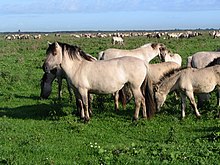Konik
striped dun | |
The Konik or Polish Konik (Polish: konik polski) is a Polish breed of pony. There are semi-feral populations in some regions. They are usually mouse dun or striped dun in color.
The Bilgoray (
The word "konik" means 'small horse'. It may be used in a wider sense to describe the Polish Konik and other similar breeds, among them the
: 481Etymology
The Polish word konik (plural koniki) is the diminutive of koń, the Polish word for "horse" (sometimes confused with kuc, kucyk meaning "pony").[citation needed] It means 'small horse'.[4]: 481
History

The Konik is a Polish
During World War I, these horses were important transport animals for Russian and German troops and were called Panje horses.[5] In 1923, Tadeusz Vetulani, an agriculturalist from Kraków, started to get interested in the Panje horses, a landrace of Biłgoraj and coined the name “Konik” (Polish for “small horse”), which is now established as the common name for the breed. During the 1920s, several public and private studs were created to conserve this animal.[5] In 1936, Vetulani opened a Konik reserve in the Białowieża Forest. He was convinced that if horses were exposed to natural conditions, they would redevelop their original phenotype.[5] While Vetulani's experiments are well-known and widely publicized,[8][9] his stock actually had only a minor influence on the modern Konik population.[5] However, World War II marked the end of Vetulani's "breeding back" project. Part of his stock was moved to Popielno, where they continued to live in semiferal conditions. Popielno became the breed's main stud during the 1950s, but the herd was also preserved by buying animals from Germany.[5]
Between the two world wars, the German brothers Heinz and Lutz Heck crossed stallions of
Characteristics
The breed has a strong and stocky build, small head with a straight profile, and a neck set low out of the chest. The Konik has a deep chest, a thick mane, and the hair coat is blue dun, often colloquially called "mouse-gray". The Konik is short in height, ranging from 130–140 cm (12.3–13.3 hands).[11] Minimum heartgirth measurement is 165 cm (65 in), and minimum cannon bone measurement 16.5 cm (6.5 in) for mares, 17.5 cm (6.9 in) for stallions.[12] Weight is 350–400 kg (770–880 lb).[13]
Breeding centres and nature reserves

Koniks today are bred either in barns or open reserves and under human guidance. The Konik was bred for a larger shoulder height in past decades, to improve its value as a working horse. A more graceful appearance, especially of the head, was established, as well. Black and sorrel horses have been largely selected out, but still appear on occasion, as do white markings.[5] The simultaneous management of Koniks in both barns and reserves made it possible to compare the health and behaviour of the horses under different circumstances. For example, hoof diseases and hay allergies are more common in Koniks raised in barns than in reserves.[5]
In Poland, Koniks currently live on nature reserves at Popielno,
Oostvaardersplassen, the Netherlands
As it is claimed to phenotypically resemble the extinct tarpan,
References
- ^
Barbara Rischkowsky; Dafydd Pilling, eds. (2007). List of breeds documented in the Global Databank for Animal Genetic Resources (PDF). Archived from the original (PDF) on 2020-06-23.
- annex to
ISBN 9789251057629. Archived from the original(PDF) on 2017-01-10. - ^ a b Konik polski / Poland (Horse). Domestic Animal Diversity Information System (Report). Breed data sheet. Food and Agriculture Organization of the United Nations. Retrieved 4 December 2021.
- ^ a b
Rousseau, Élise; le Bris, Yann; Fagan, Teresa Lavender (2017). Horses of the World. Princeton, NJ: Princeton University Press. ISBN 9780691167206– via Google Books.
- ^ a b c
Porter, Valerie; Alderson, Lawrence; Hall, Stephen J.G.; Sponenberg, D. Phillip (2016). Mason's World Encyclopedia of Livestock Breeds and Breeding (6th ed.). Wallingford: CABI. ISBN 9781780647944– via Google Books.
- ^ ISBN 3-89432-913-0
- ^ Jansen et al. 2002: Mitochondrial DNA and the origins of the domestic horse
- ^ Cieslak et al. 2010: Origin and History of Mitochondrial DNA lineages in domestic horses
- ^ Piotr Daszkiewicz (2003), "Konik Polski."
- ^ http://www.staff.amu.edu.pl/~vetulani/tadeusz/pl/index.html Archived 2016-03-03 at the Wayback Machine and translation
- ISBN 9783000243851
- ^ Stud-book of Origin of Konik polski breed Archived 2016-02-20 at the Wayback Machine. Polski Związek Hodowców Koni (Polish Horse Breeders Association). Accessed 4 December 2013.
- ^ Księgi stadne (in Polish). Stadniny Izery. Accessed 4 December 2013.
- ^ Koniki dzisiaj (in Polish). Stadniny Izery. Accessed 4 December 2013.
- ISSN 1644-0676.
- ISBN 0791418898– via Lee Boyd & K.A. Houpt 1994.
- ^ cijfers Staatsbosbeheer Dossier Oostvaardersplassen mutaties 2011
- ^ a b c d Provincie Flevoland (2020). "Grote grazers in de Oostvaardersplassen" (PDF). flevoland.nl (in Dutch).
- ^ Staatsbosbeheer. "Lange winter voor grazers in de Oostvaardersplassen" (in Dutch). Archived from the original on 2014-08-17.
- ^ Marris, Emma (2011). Rambunctious Garden: Saving nature in a post-wild world.
- ^ "Opnieuw rechtszaak over slacht konikpaarden uit Oostvaardersplassen". nos.nl (in Dutch). 2021-06-23. Retrieved 2023-03-10.
Further reading
- Konik horses - Rare horse breed proves crucial to delicate ecosystem Horsetalk.co.nz
- Maas, P.H.J. 2006. Selective breeding. The Extinction Website. Downloaded at 27 August 2006.
- Maas, P.H.J. 2006. Tarpan - Equus ferus ferus. The Extinction Website. Downloaded at 27 August 2006.
- Markerink, M., 2002. Koniks, wilde paarden in Nederland. Stichting Ark, Hoog Keppel.
